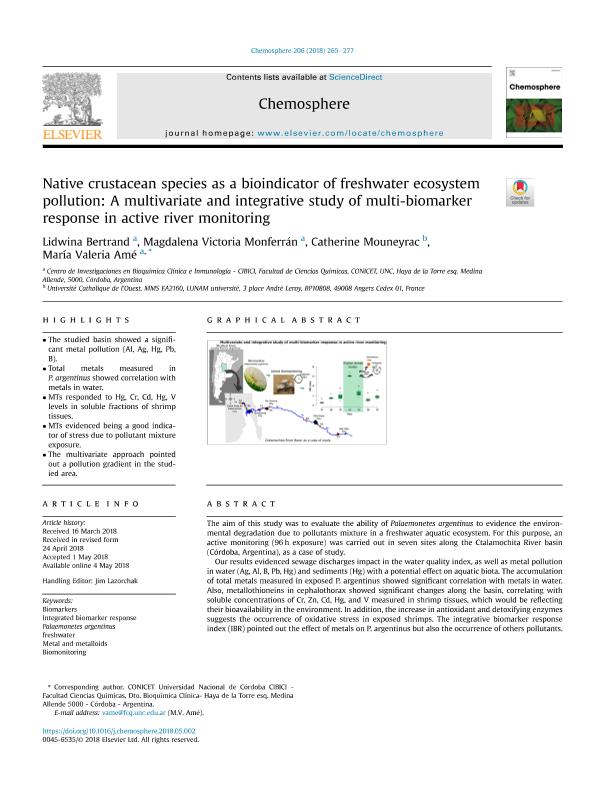Mostrar el registro sencillo del ítem
dc.contributor.author
Bertrand, Lidwina

dc.contributor.author
Monferran, Magdalena Victoria

dc.contributor.author
Mouneyrac, Catherine
dc.contributor.author
Amé, María Valeria

dc.date.available
2019-10-09T13:38:27Z
dc.date.issued
2018-09
dc.identifier.citation
Bertrand, Lidwina; Monferran, Magdalena Victoria; Mouneyrac, Catherine; Amé, María Valeria; Native crustacean species as a bioindicator of freshwater ecosystem pollution: A multivariate and integrative study of multi-biomarker response in active river monitoring; Pergamon-Elsevier Science Ltd; Chemosphere; 206; 9-2018; 265-277
dc.identifier.issn
0045-6535
dc.identifier.uri
http://hdl.handle.net/11336/85434
dc.description.abstract
The aim of this study was to evaluate the ability of Palaemonetes argentinus to evidence the environmental degradation due to pollutants mixture in a freshwater aquatic ecosystem. For this purpose, an active monitoring (96 h exposure) was carried out in seven sites along the Ctalamochita River basin (Córdoba, Argentina), as a case of study. Our results evidenced sewage discharges impact in the water quality index, as well as metal pollution in water (Ag, Al, B, Pb, Hg) and sediments (Hg) with a potential effect on aquatic biota. The accumulation of total metals measured in exposed P. argentinus showed significant correlation with metals in water. Also, metallothioneins in cephalothorax showed significant changes along the basin, correlating with soluble concentrations of Cr, Zn, Cd, Hg, and V measured in shrimp tissues, which would be reflecting their bioavailability in the environment. In addition, the increase in antioxidant and detoxifying enzymes suggests the occurrence of oxidative stress in exposed shrimps. The integrative biomarker response index (IBR) pointed out the effect of metals on P. argentinus but also the occurrence of others pollutants. Finally, a high consensus was observed for water, sediments, and shrimps through the multivariate analysis (90%), indicating that P. argentinus can reflect changes in the abiotic matrixes. Moreover, studied sites were grouped according to their environmental quality. The use of active biomonitoring and the integration of biological responses through an IBR confirm that native biota could be a useful monitoring tool for bioavailable pollutants in aquatic ecosystems constituting a highly valuable approach.
dc.format
application/pdf
dc.language.iso
eng
dc.publisher
Pergamon-Elsevier Science Ltd

dc.rights
info:eu-repo/semantics/openAccess
dc.rights.uri
https://creativecommons.org/licenses/by-nc-sa/2.5/ar/
dc.subject
BIOMARKERS
dc.subject
BIOMONITORING
dc.subject
FRESHWATER
dc.subject
INTEGRATED BIOMARKER RESPONSE
dc.subject
METAL AND METALLOIDS
dc.subject
PALAEMONETES ARGENTINUS
dc.subject.classification
Otras Ciencias Químicas

dc.subject.classification
Ciencias Químicas

dc.subject.classification
CIENCIAS NATURALES Y EXACTAS

dc.title
Native crustacean species as a bioindicator of freshwater ecosystem pollution: A multivariate and integrative study of multi-biomarker response in active river monitoring
dc.type
info:eu-repo/semantics/article
dc.type
info:ar-repo/semantics/artículo
dc.type
info:eu-repo/semantics/publishedVersion
dc.date.updated
2019-09-30T18:31:00Z
dc.journal.volume
206
dc.journal.pagination
265-277
dc.journal.pais
Estados Unidos

dc.description.fil
Fil: Bertrand, Lidwina. Consejo Nacional de Investigaciones Científicas y Técnicas. Centro Científico Tecnológico Córdoba. Centro de Investigaciones en Bioquímica Clínica e Inmunología; Argentina
dc.description.fil
Fil: Monferran, Magdalena Victoria. Consejo Nacional de Investigaciones Científicas y Técnicas. Centro Científico Tecnológico Conicet - Córdoba. Instituto de Ciencia y Tecnología de Alimentos Córdoba. Universidad Nacional de Córdoba. Facultad de Ciencias Químicas. Instituto de Ciencia y Tecnología de Alimentos Córdoba; Argentina
dc.description.fil
Fil: Mouneyrac, Catherine. Université Catholique de l’Ouest; Francia
dc.description.fil
Fil: Amé, María Valeria. Consejo Nacional de Investigaciones Científicas y Técnicas. Centro Científico Tecnológico Córdoba. Centro de Investigaciones en Bioquímica Clínica e Inmunología; Argentina
dc.journal.title
Chemosphere

dc.relation.alternativeid
info:eu-repo/semantics/altIdentifier/doi/https://doi.org/10.1016/j.chemosphere.2018.05.002
dc.relation.alternativeid
info:eu-repo/semantics/altIdentifier/url/https://www.sciencedirect.com/science/article/pii/S0045653518308440
Archivos asociados
